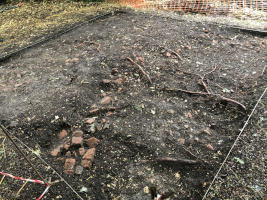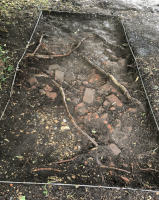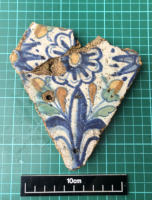07 Jul 2025
Summer Dig Day 2

Excavation continued today, on day two of our two-week exploration of the inner gatehouse of Elsyng palace.
We finished removing topsoil in both trenches to reveal a coarse rubble deposit that had started to appear yesterday, and at first seemed to form a line across Trench 1, possibly continuing in Trench 2.
We began to speculate whether this rubble may represent the 'tumble' of a demolished wall, especially given that its apparent line would run roughly paralell with the wall with integral columns we excavated nearby in 2023 (see day 1 for diagram) - and so could be the first signs of a back edge to our gatehouse building.

Early in the afternoon, once it was recorded, we began removing the rubble from Trench 2, only to find a layer of pebbles beneath it.
Progress in Trench 1 is slightly behind Trench 2, but early indications are that it follows the same sequence, i.e. the 'tumble' is overlaying a gravel deposit and not directly over a wall line. As work continued in Trench 2, it began to show a second rubble layer beneath the pebbles, which is a pattern we have seen before at Elsyng; i.e. more than one demolition phase, separated by a period of pebble landscaping.
Assuming Trench 1 follows the same pattern we can therefore expect to remove the rubble to reveal the pebble deposit tomorrow before moving on to an underlying second rubble context, which in turn will hopefully reveal the actual surviving palace structure beneath.
There are one or two interestingly shaped bricks in amongst the rubble especially in Trench 1, including parts of window mullion, a complete corbel and various chamfered bricks, but the best find of the day was an almost complete lozenge-shaped polychrome English Delft tile.

It is one of the largest intact Delft tile pieces ever found at Elsyng and evidently part of an elaborate set of tiles that would have once graced a high status room within the palace.
We hope that the complete design will be identifiable and should be closely dateable - we suspect that this is an example from the Pickleherring Pottery that operated in Southwark for most of the seventeenth century.